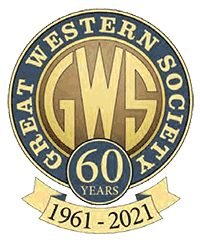Hand Crane No. 205 project
Introduction
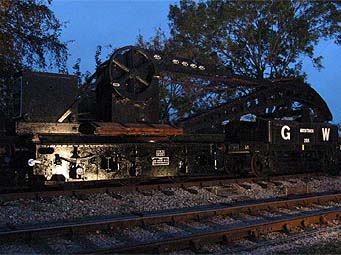
R J Heron 28-Oct-2006
GWR 12 ton travelling Hand Crane No. 205 was one of the Society's earlier acquisitions but, having been out of use for many years, it was starting to look very tired and was in danger of becoming that terrible thing - 'A disgrace to the Society'. There had even been some talk of getting rid of it ...
Luckily there were some who realized the importance and undoubted 'Great Western-ness' of these vehicles, and rather than proclaiming that 'they' should do something about it, went out, bought a can of rustproofing paint, worked out how to operate a needle-gun, and set to work.
Between 1998 and 2006 the Bristol Group of the Society undertook the cosmetic restoration of these historic vehicles, in between other commitments.
History of the Vehicles
Number 205 is a GWR 12 ton travelling hand crane, built at Swindon Works to Order No. H2827 of 22/11/1892 entering service in circa. 1894. In removing old paint from the balance box of the crane there is clear evidence that the cast letters ‘GWR Swindon 1893’ have at some stage been ground away from both side panels. However the Makers Plate carries the date of 1894.
This type of crane was generally used to provide heavy lifting capacity in goods yards, where either a fixed crane was not provided, or where that provided was of insufficient capacity for a particular load. They were also used for a variety of engineering purposes.
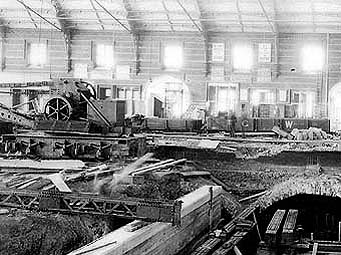
Photo: Courtesy of STEAM - Museum of the Great Western Railway
The history of the Match Truck, used to support the overhang of the jib when the crane is travelling as well as for the storage of slings, chains, packing timber and other such useful equipment, is unclear. The original match truck for crane No. 205 is recorded as being built to Diagram L3, Lot 16, completed, 4/1894. Diagram L3 however shows a vehicle different in some respects from the current match truck. For instance Diagram L3 shows a vehicle with a lever brake on one side only whereas the current wagon has a cross-cornered Dean-Churchward brake. The wagon also differs from Diagram L3 in having self contained buffers and a post-1914 coupling plate. There are further anomalies relating to the tare weight of the vehicle and the length of the tool cupboards. It would seem that either the original match truck has been heavily modified at some stage as the result of wear and tear or an accident, or, more probably, that a replacement match truck has been provided from a condemned or damaged crane.
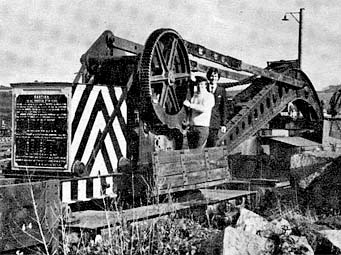
Photo: Peter Lemar - 1969
The vehicle as it is now is not an exact match with any GW match truck diagram, has no useful stamped dates or numbers, and no telltale bolt holes to show where modifications have taken place. We have so far been unable to trace any record of the truck's modification or manufacture and no photographs of the crane in service. At present it seems likely that the origins of this vehicle may remain a mystery - any further clues will be gratefully received !
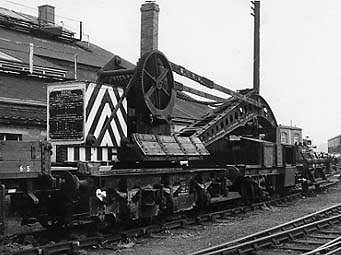
15-May-1971
The Hand Crane and accompanying Match Truck were spotted by Society members in the late 60s at Hackney Yard, Newton Abbot and were subsequently acquired by the Society and moved to Didcot.
In the early days at Didcot the crane was maintained in working order and was much used for tracklaying, boiler lifts and even removing wheelsets from smaller locomotives.
However since the arrival of the less labour intensive steam and diesel 5 ton cranes the hand crane has seen little use and the condition of the vehicles had deteriorated considerably, most of the cast plates had been removed for safe keeping and the pair presented a somewhat derelict appearance to visitors.
A small section of the match truck had been painted by an unknown volunteer a few years ago, but sadly the work had progressed no further, and by 1998 even this work was starting to deteriorate
The Project
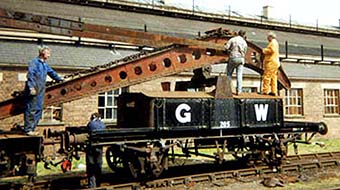
Photo: R J Heron - Aug-98
Bristol Group's restoration of the vehicles started at Work Week in August 1998 when the jib was removed to improve access to the Match Truck. Initial restoration work concentrated on the truck. Firstly all of the footplating was cut away allowing for the first time a good view of the underframe. This was sufficiently alarming that as a consequence several parts of the internal bracing were cut away and new lengths of steel angle welded in. The underframe, brake gear and running gear was then comprehensively needle-gunned and painted with two coats of rust-inhibiting primer and a top coat, a statement which is easy to make but which describes an activity that took the best part of a year to achieve. New footplating was welded in throughout the truck and extensive patch repairs undertaken to the backs and tops of the tool cupboards which had corroded badly.
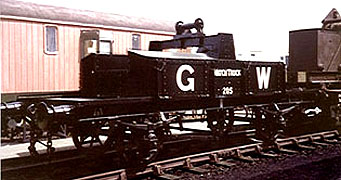
Photo: R J Heron - Aug-2000
A multitude of minor repairs were undertaken such as releasing the screw couplings which had seized, and replacing some of the pins and chains which hold the doors in position. The various cast iron plates have been cleaned up and new plates made where necessary. The plates have now been permanently attached to the vehicle. The superstructure was then needle gunned, painted and eventually lettered.
In summer 2000 work started on the crane itself. Fortunately the crane had not suffered from rusted-through platework to the same extent as the match truck. However much of the footplating had rusted-through and was cut away from the crane revealing supporting steelwork in a much better condition than that of the Match Truck.
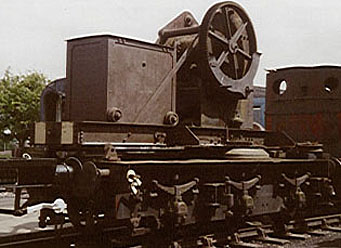
Photo: R J Heron - Aug-2000
All brackets etc. which were attached to the footplating were removed for restoration and reinstatement. The remaining footplating - being the heavier gauge plate which carries the crane traverse mechanism - has been cleaned and repainted.
Work continued with the needle-gunning and painting of the superstructure, whilst releasing and lubricating the mechanism where possible. Many of the original cast iron signs from the balance box were in store at Didcot and these have been restored and securely refitted. New steel was purchased for the floor of the crane and was fitted by tack welding in place. The fittings which stop the crane from slewing whilst travelling have been refitted to the footplating using new hardwood packing blocks.
Work in 2002 concentrated on the jib. Much of the underside had severely rusted and so a large part of the original was cut away. Due to the complexity of the shape, finished pieces were ordered and these were made by a profile cutter and delivered to site. The five pairs of cast plates which indicate the radius at which the jib has been set had all cracked into many pieces some time ago and the remains of these were removed and taken to our pattern maker who made patterns and had suitable replacements cast.
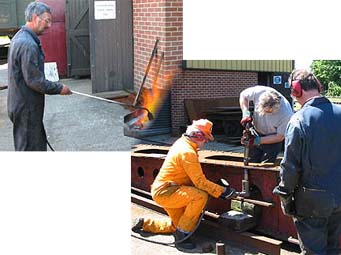
26-Jun-02
In June the replacement plates were riveted in place with technical assistance and gentle advice supplied by Pete Gransden (Thanks!). Once this was achieved, the outside of the jib was needle-gunned and the jib painted in primer. The jib was then ready for refitting to the crane after an absence of four years.
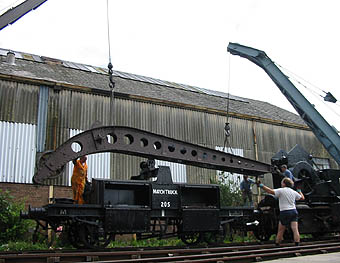
A Braben 8-Aug-02
The jib was subsequently painted up to top coat by the end of 2002. Other more urgent activities interrupted the restoration, and little further work was undertaken during 2003-2005.
One of the challenges has been to replace those cast iron plates which were either missing entirely or broken and partially missing. One particular plate had baffled for some time. It was thought to be a British Rail era plate, but there was just insufficient remaining to be sure of the exact wording. A two year campaign of diligently studying every preserved Great Western hand crane that we could find, finally paid off when a crane was spotted in the loop at St. Mary's Halt on the Dean Forest Railway, proudly carrying a plate which is an exact match of the remains of our broken plate.
The plate was duly photographed and once again we were able to deliver the remains of the old plate and a copy of this photograph to our pattern maker and subsequently to receive a nice new plate in return.
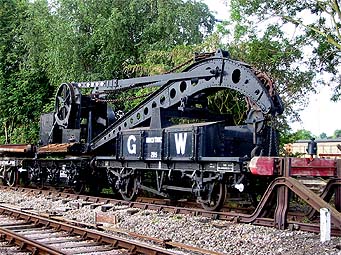
R J Heron 5-Aug-06
The remaining work, primarily the reconstruction of the folding wooden platforms from which the crane operators worked, the fitting of further original and replacement cast notices and the needle-gunning and painting of the frames of the crane itself were undertaken in the spring and summer of 2006, being completed during work week in the first week of August.
The project was intended to take two to three years, but has actually taken eight (albeit with a three year break in the middle).
However we have produced a pair of vehicles which whilst non-operational at least have a cared for appearance.
Bibliography
|
Great Western Echo — No.??. Winter 1969. |
|
AG Atkins, W Beard, R Tourret. 1998.
GWR Goods Wagons - A Historical Survey (new edition). Tourret Publishing, 5 Byron Close, Abingdon Oxon OX14 5PA. ISBN 0 905878 07 8. |

Many of the original Great Western drawings for this type of hand crane and match truck are in the Railway Drawings Collection Records -2515/400 series at the Wiltshire and Swindon Record Office.
| Archive Reference | Description | Date |
|---|---|---|
| 2515 / 409 / 0892 ms | Diagram of 12T Travelling Hand Crane No 205 | 1923 |
| 2515 / 404 / 1933 ms | 12T Travelling Hand Crane - Wrought Iron Details of Brake Gear | 1897 |
| 2515 / 404 / 1921 ms | 12T Travelling Hand Crane - Slewing Gear | 1898 |
| 2515 / 404 / 1924 ms | 12T Travelling Hand Crane - Cast Iron Details of Brake Gear | 1899 |
| 2515 / 404 / 1964 ms | 12T Travelling Hand Crane - Alteration to Frame Plates & Details | 1895 |
| 2515 / 404 / 1939 ms | Match Truck for Cranes Nos. 205, 201, 405, 406. | 1968 |
| 2515 / 404 / 1965 ms | 12T Travelling Hand Crane - Roller Path and Pillar | 1893 |
| 2515 / 404 / 1931 ms | 12T Travelling Hand Crane - General Arrangement of Brake Gear | 1899 |
| 2515 / 404 / 1932 ms | 12T Travelling Hand Crane - Fencing for Gear | 1898 |
| 2515 / 404 / 1925 ms | 12T Travelling Hand Crane - Standard Rail Clips | 1896 |
| 2515 / 404 / 1960 ms | 12T Travelling Hand Crane - Roller and Carrier | 1887 |
| 2515 / 404 / 1961 ms | 12T Travelling Hand Crane - Cast Iron Details | 1887 |
| 2515 / 404 / 1949 ms | 12T Travelling Hand Crane - Jib & Details | 1893 |
With thanks also to:
- Austin Attewell (The Pendon Museum Trust)
- Peter Cattermole (The Somerset and Dorset Railway Trust)
- Frank Dumbleton (Great Western Society)
- David Hyde (Great Western Society)
- Peter Lemar (Great Western Society)
and
- STEAM - Museum of the Great Western Railway
- The National Railway Museum
for their assistance with researches into the history of GWR hand cranes, and the provision of photographs.
